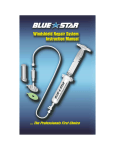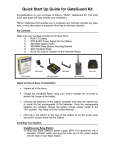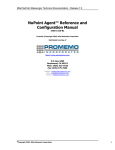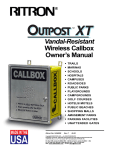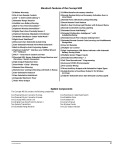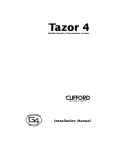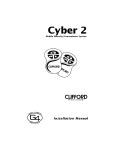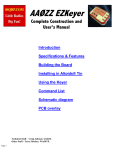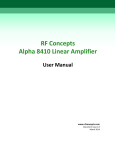Download CALL24 Mark III Callbox User Manual September 2007
Transcript
CALL24 Mark III
Callbox User Manual
September 2007
Overview
This device is used as an emergency communications call box for remote areas
such as parking lots, walkways, or other locations not having easy access to
telephone lines. Communications from the call box to security personnel is done
via two-way radio or cellular phone. To use, the user presses a call button on
the front panel, which causes the unit to activate a strobe light and send one
prerecorded voice message to the caller and another voice message to security.
The message to security would typically state the nature of the call and the location of the call box, while the message to the caller might state that the call
is underway. Security responds by sending a coded signal back to the call box to
enable it for two-way communications with the caller. Once enabled, the call
box button becomes a push-to-talk switch, allowing the caller to talk directly to
security. When a cell phone is being used the call box becomes totally hands
free. When communications have ended, security can send another coded signal
to the box to re-arm it for another emergency call and deactivate the strobe.
Many of the features of the callbox described here are programmable by the
factory and/or dealer.
Technical Summary
1
Hardware Components
1
The Software
1
Idle Mode
2
Call Initiation
3
Call Progress, Radio
3
Call Progress, Phone
5
TEST Pushbutton (Call Type 5)
8
Tamper Detection (Call Type 6)
9
Low Battery (Call Type 7)
9
Listen Mode
10
Talk Mode
11
With Radio
11
With Telephone
12
Quiet Mode
13
DTMF Commands
14
DTMF Command List
14
Digital Outputs
17
Auto-Test
18
NightLight
19
ANI Codes
19
Heartbeat
21
Power Management
22
Battery Charging
22
Low Battery Calls
24
Hibernation Mode (near-zero power operation) 25
External Device Power Control
25
Technical Summary
Hardware Components
The components which make up the call box system are: (1) The call box controller, (2) two-way radio or cellular phone adapter, (3) rechargeable battery,
(4) power supply delivering 15 volts DC @ 4 amps, (5) speaker & microphone, (6)
RED and GREEN front panel lights (LEDs), (7) up to four front panel pushbutton CALL switches, (8) a strobe light and a nightlight, and (9) a vibrationsensing tamper switch and other normally closed switches wired in series to
sense theft or vandalism. Not part of the call box unit itself, but required for
use, is a security guard or equivalent with two-way radio or telephone who will
be responsible for responding to calls made from the call box. The controller is
computer-based, and governs the overall operation of the call box. The controller has the capability of receiving and decoding DTMF signals (commands) sent
from the security station. It also is responsible for activating the radio’s pushto-talk switch or placing a call via the cell phone, routing audio signals from the
microphone or from the voice storage & playback system to the radio or cell
phone (for transmission), routing audio signals from the radio, cell phone or the
voice system to the front panel speaker, controlling the RED and GREEN lights,
the strobe and the nightlight.
The Software
In the software for the callbox there are several modes of operation, and a
few sub-modes. The main modes are Idle and Talk modes, where in Idle mode
the callbox software is waiting for some event to take place and in Talk mode it
is controlling two-way communications between the security office and the
caller, either by 2-way radio or telephone (landline or cell phone adapter).
Listen mode is a sub-mode of Idle or Talk mode, and this defines the condition
where the caller (the person near the callbox) cannot hear any communications
from security but security can hear what is being said near the callbox. The
callbox can be in Idle mode or Talk mode and temporarily be switched to Listen
for a predetermined length of time, at which time it will automatically revert
1
back into whatever mode was in effect before the switch. Listen mode is primarily used for security to listen to any activity in the vicinity of the callbox
without anyone near the callbox being aware of it.
Quiet mode is a sub-mode of Talk mode, and this defines the condition where a
call is taking place without any indication at the callbox that it is doing so.
Quiet mode is useful for Tamper alarms and Low Battery calls, where the call is
normally intended to provide a prerecorded message to security only, and not
intended for 2-way communications between the callbox and security.
There are subtle differences in these modes depending on whether the callbox
is equipped with a 2-way radio or a phone. The fundamental difference is that a
phone provides for 2-way full duplex operation, and when connected via phone,
the communications path is to the called party only as opposed to the potential
party-line communications method with a 2-way radio.
Idle Mode
When idle the red and green LEDs are off, the strobe is off, and the radio is
not transmitting or the phone is on hook. The microphone and speaker are both
muted. The unit is monitoring (1) the call button(s) and the TEST button, (2)
the tamper switch and other switches in the security current loop (3) battery
level, and (4) received DTMF tones from the radio or an incoming call via the
phone, and (5) the "Menu" key of the keypad. When any of these events occur
the unit will leave idle mode and perform the functions required by the event.
These are described in the following sections. If the controller receives either
of the two activation codes via radio it will immediately enter Talk mode. If it
receives the Listen code it will enter Listen mode, and if it receives one of the
digital output activation codes it will activate the specified output. These are
the only DTMF codes the unit will respond to while in Idle mode and a 2-way
radio is being used. If a phone is being used then an incoming call will either
cause the unit to pick up the phone and enter Talk mode (with Quiet mode in
1
Call24 Mark III February 11, 2011
2
effect) or place a call using one of the programmed callback numbers once the
incoming rings have stopped (see Operating With Cell Phone).
Call Initiation
A call to security is initiated when any of the four possible front panel CALL
buttons are pressed, or the TEST switch is pushed, or the tamper circuit is
triggered, or when a low battery is detected, or automatically when programmed to make a TEST call at periodic intervals. A TEST call to security is
also made when using a phone and the "Callback" feature is enabled and activated. All call types are handled in the same manner by the controller. There is
nothing that distinguishes one call type from another other than the messages,
features and timeouts which are programmed by the factory or dealer. One minor exception is a TEST call. See Test Button. There are 7 "call types" (CT).
They are:
1. Call switch #1
2. Call switch #2
3. Call switch #3
4. Call switch #4
5. TEST switch
6. Tamper alarm
7. Low battery
When activated and a 2-way radio is being used, all calls are processed in the
manner described below. The features which are programmable are shown as a
link (in blue) to the corresponding section in Setup Mode.
Call Progress, Radio
1
2
The front panel green LED will be ON or OFF (Quiet Mode) while
any CALL button is pressed to initiate a call.
The strobe light will be ON or OFF (Quiet Mode).
Call24 Mark III February 11, 2011
3
3
4
5
6
7
8
A voice message for the caller corresponding to the call type will or
will not (Caller Messages On) be played repeatedly at the local
speaker for the benefit of the caller.
The callbox will or will not (COR) wait for a clear channel via the
COR signal provided by the radio or by the controller’s audio detection circuits. The maximum wait time for the COR has a default
value of 30 seconds.
The radio transmitter is keyed and ANI codes will or will not (ANI
ON) be transmitted.
A voice message for security corresponding to the call type, and a
common location message (Security Message #8) will or will not
(Security Messages On) be transmitted to security simultaneously
with the user message in step #3.
Step #6 will be repeated a programmed number of times (Message
Repeat Count). The caller message will be repeated continuously (if
enabled) until the callbox is activated (or deactivated).
The radio will be unkeyed and the unit will or will not (determined
by Auto-Activate) wait for a programmable period of time
(Activation Timeout) for an activation code to be sent from security which will place the unit in Talk mode. If programmed for
Auto-Activation the unit will enter Talk mode immediately after
playing the security message(s). If the activation timeout expires
with no activation code received the unit will repeat from step #5
if the Call Timeout timer has not expired. If the programmed Call
Timeout has expired the unit will play the Call Failure Message to
the caller (caller message #8), then terminate the call and revert
to Idle mode. A separate call timeout is provided for each call type.
(Exception: If the activation timeout is set for 0 seconds there will
be no activation timeout, therefore the activation time should normally not be programmed for 0 seconds, as this would cause steps
#5-8 to be repeated indefinitely.)
Call24 Mark III February 11, 2011
4
After an activation code is received (or if auto-activate is enabled)
the unit will enter Talk mode. The red front panel LED will or will
not (Quiet Mode) be lit. Any of the CALL buttons now become
push-to-talk buttons. When pressed, the green front panel LED will
9 be lit and the caller’s voice will be transmitted via radio to security;
when released the audio from the radio will be heard at the callbox
speaker. The caller is allowed to transmit for a limited time (Talk
Timeout) for every push of one of the call buttons. If this time expires the green LED will go out and the radio will stop transmitting.
The Call Timeout timer is reset to zero upon every push of any
CALL switch while in Talk mode and whenever any DTMF signal is
10
heard from the radio. Upon timeout the call will be terminated and
the unit will revert to Idle mode.
Upon receiving the deactivation code the call will terminate and the
11
unit will revert to Idle mode.
When activated and a telephone is being used, all calls are processed as shown
below:
Call Progress, Phone
1
2
3
The front panel green LED will be ON or OFF (Quiet Mode) when
any CALL button is pressed to initiate a call. It will remain ON until the call is terminated.
The strobe light will be ON or OFF (Quiet Mode).
A voice message for the caller corresponding to the call type will
or will not (Caller Messages On) be played repeatedly at the local
speaker for the benefit of the caller. However, if there is no line
current or no dialtone (when Dialtone is enabled) then the Call
Failure Message (caller message #8) will be played for the caller
and the call will terminate.
Call24 Mark III February 11, 2011
5
The first (or second) programmed phone number (Number to Call)
will be dialed by the callbox. If no answer or the call is busy then
the 2nd programmed number will be dialed. If this is the 2nd
4
number being dialed and there is no answer or the number is busy,
then the call failure message will be played for the caller and the
call will terminate.
When Auto-Activate is ON: The unit will wait for the occurrence
of any sound on the line which is not either a busy signal or ringback tone. When heard, the unit will classify the call as having
been answered. If a busy signal is heard or if 8 (programmable
number) ringback tones are heard the unit will hang up the call and
repeat from step #4, using the 2nd phone number. If this call is
already the 2nd phone number then the call failure message will be
played for the caller (if Caller Messages are ON) and the call will
5-A
terminate. The Activation Timeout setting is ignored when AutoActivate is on (exceeding the allowed number of ringback tones is
the event which terminates a call attempt, not a timeout). When
the call is answered the ANI codes will or will not (ANI ON) be
sent to the called party, followed by the voice message for security corresponding to the call type, and a common location message, provided that Security Messages On is enabled for this call
type.
Call24 Mark III February 11, 2011
6
When Auto-Activate is OFF: The unit will wait for a programmable
period of time (Activation Timeout) for the detection of any
DTMF tone sent by the called party, while simultaneously playing
the security messages to the called party repeatedly (if Security
Messages are ON, which they should be). When any DTMF is
heard, the unit will classify the call as having been answered and
will send the ANI codes if they are enabled (ANI ON). If the activation timeout expires with no DTMF tone received the unit will
5-B
hang up the call and repeat from step #4, using the 2nd phone
number. If this call is already the 2nd phone number then the call
failure message will be played for the caller and the call will terminate. If the activation timeout is set for 0 seconds there will be
no call timeout, therefore the activation time should normally not
be programmed for 0 seconds. (Note: part of the voice message
sent to the called party should contain instructions for them to
press any key to activate the callbox and begin talking.)
Once the call is classified as having been answered, the unit will
enter Talk mode. Both the red and green front panel LEDs will or
will not (Quiet Mode) be lit. The caller is now free to converse
with the called party in semi-full duplex, without having to push
6
any buttons to talk. Exception: If Quiet Mode is enabled the
caller will not hear anything from the callbox speaker nor will any
of the front panel LEDs be lit, although security will hear everything being said near the callbox. Quiet mode may be turned off
by security sending the activation code once in Talk mode.
The Call Timeout timer is reset to zero whenever any DTMF signal
is heard from security. A short beep will be sent to both security
and the caller 5 seconds prior to the call timeout (intended to
alert security that a call disconnect is imminent). Upon timeout
7
the call will be terminated and the unit will revert to Idle mode.
When the call is terminated a series of 5 short beeps will be sent
to security and the caller to notify them that the call has disconnected.
Call24 Mark III February 11, 2011
7
8
Upon receiving the deactivation code or if a line-break is detected
the call will terminate (after 5 beeps are sent) and the unit will
revert to Idle mode. The deactivation code for a cell phone may
optionally be "##". ( A line-break is a special line condition sent
by most telephone equipment to signal that the distant party has
hung up.)
TEST Pushbutton (Call Type 5)
When the TEST pushbutton is pressed the callbox will make a call as described
above, with two exceptions. (1) Prior to the call the callbox will sound a short
beep to the speaker and attempt to detect this beep at the microphone. This is
done to test the integrity of the speaker/mic combination, and the result of
this test is included as part of the ANI codes sent when the call is connected.
(2) The controller will turn off AC power while a TEST call is underway in order
to test the battery condition. If the battery is found to be low during the test
call, or if the controller loses power completely due to a dead battery, it will
make a Low Battery call as soon as the test call has ended or it has recovered
from the power failure. A Low Battery call after a power failure may take up to
1 minute to be initiated after power is restored.
The TEST pushbutton performs a different function once a call is underway. If
pushed while the callbox is waiting for an activate/deactivate code, or detection of an answered phone call, the callbox will behave as though the event it is
waiting on has occurred. This is intended to aid in testing or troubleshooting a
misbehaving callbox.
Also see Auto-Test.
Call24 Mark III February 11, 2011
8
Tamper Detection (Call Type 6)
When the tamper switch is activated by severe vibration, or if the security
current loop circuit is opened via any of several series-connected normally
closed switches, or if the nightlight is removed, the controller will initiate a call
as described above. This call type would typically be programmed for Quiet
Mode, which sets the front panel LEDs and front panel speaker to be disabled
during call activation. It would also be programmed for Auto-Activate, so that
after the ANI and voice messages have been sent the unit would enter Talk
mode immediately. Quiet mode would still be in effect once the unit entered
Talk mode, so that Listen could be activated without alerting anyone in the vicinity (applies to radio only - telephone operation is inherently in Listen mode
due to the full duplex nature of the call). If an Activation code is received it
will turn off Quiet Mode and allow security to have 2-way communications with
the call box.
There are three tamper inputs to the controller. One is a vibration sensor, the
second is a circuit that senses the removal of the nightlight, and the third is a
current loop circuit that must be a closed circuit for a no-alarm condition. A
mercury tilt switch, door ajar, or any other normally closed switch may be connected into this loop, where any opened switch anywhere in the loop will activate the tamper alarm. To disable the tamper alarms during servicing an electrical keyswitch accessible from the outside of the unit should be wired so as
to short the tamper current loop input to circuit ground to deactivate the loop
switches. Also, a second pole of this same switch should be used to open the
circuit to the tamper vibration sensor so that it too is disabled prior to gaining
access to the callbox.
Low Battery (Call Type 7)
When the controller senses a low battery condition, it will initiate a call as described above. This call type would typically be programmed for Quiet Mode,
which sets the front panel LEDs and front panel speaker to disabled during call
activation. It would also be programmed for Auto-Activate, so that after the
Call24 Mark III February 11, 2011
9
ANI and voice messages have been sent the specified number of times the unit
would enter Talk mode immediately. Furthermore, it would be programmed for a
Talk Mode Timeout of a time period of 1 second. This would cause the low battery message to play the desired number of times and the call would be terminated 1 second after completion of the messages.
Once a low battery message has been sent, the unit will not repeat a low battery call until the battery has been charged for 1 hour. This is to help prevent
the possibility of the controller sending multiple low battery warnings as the
battery teeters on the brink of the threshold of good-to-weak.
Detecting a weak battery is difficult while AC is present and the charger is
charging the battery. The only reliable way is to sense the battery voltage under load. When AC or solar power is not present this requirement is met, so low
battery detection while operating under battery power is accurate and reliable.
So in order to test the battery during charging a TEST call must be placed
where the callbox controller will disconnect the AC power during the call (TEST
call only). During the TEST call if the battery is found to be weak, it will immediately place a Low Battery call after the TEST call is complete. Also, during
the TEST call if power drops so low that the callbox cannot maintain operation,
it will make a Low Battery call within about 1 minute after it recovers from the
power failure.
Listen Mode
Listen mode is a temporary mode that can be entered by the controller receiving the Listen DTMF code sequence (when using a 2-way radio). In Listen mode,
the controller activates the microphone and keys the radio for a preset time
interval (Listen Timeout) . The speaker remains muted, and no lights are lit. At
the end of the time interval the radio is unkeyed and the unit reverts to whatever mode was previously active (Idle or Talk mode). For a telephone, entering
Listen mode is inherent when answering an incoming call or when placing any call
in Quiet Mode (see next section).
Call24 Mark III February 11, 2011
10
Talk Mode
With Radio
When in this mode, if Quiet Mode is NOT in effect, the speaker is activated
and any audio being received via radio will be heard by the caller. The red LED
is lit and will stay lit as long as Talk mode is active. The CALL button becomes
the push-to-talk switch for the transmitter when using a radio. When pushed,
the green LED will light, the speaker is disengaged, the microphone is activated
and the radio is keyed. The controller will only allow the radio to be keyed for a
fixed time period (referred to as Talk Timeout, and programmable per each
CALL button) in order to guard against tampering or mechanical failure. Normally, the green LED will be lit as long as the CALL button is pressed. If the
Talk Timeout period is reached, the green LED will be extinguished even though
the CALL button is still being pressed. (The caller can release the CALL button
and push again to reset the timeout and talk.)
Note that if Quiet Mode is in effect, no LEDs are lit and the local speaker is
disabled. The caller can still push the CALL button to transmit (which also
would turn off Quiet Mode), although he/she would not normally know to do so
since there would be no visible signs that the callbox is doing anything.
If the DTMF deactivate code is received, the controller will enter Idle mode.
If the DTMF activate code is received the unit will stay in Talk mode and will
turn off Quiet Mode if it was in effect. (See DTMF commands.) The unit will
automatically enter Idle mode if the Call Timeout time expires with no activity
of the CALL button or if no DTMF tones are heard. The Call Timeout is reset
to zero on every push of the CALL button during Talk mode and upon hearing
any DTMF tones. The Call Timeout time may be set individually for each call
button, test button, the tamper alarm and the low battery alarm.
There are 2 activate codes (DTMF command “1” and “8”). Using the “1” command
will activate as described above, and using the “8” command will not only activate the callbox but will also activate OUT4 until the callbox is either deactivated, or re-activated using the “1” command. Re-activating using “1” will keep
Call24 Mark III February 11, 2011
11
the callbox activated but will turn off OUT4. OUT4 is intended to be used with
an optional relay module to connect a P.A. speaker to the callbox.
With Telephone
When in this mode, if Quiet Mode is NOT also in effect, the speaker is activated and any audio being received via the telephone line will be heard by the
caller. The red and green LEDs are lit and will stay lit as long as Talk mode is
active. Since a phone call is a full duplex system there is no need for the caller
to press any button to talk to security.
Note that if Quiet Mode is in effect, no LEDs are lit and the local speaker is
disabled. The microphone is always enabled so security can always hear what is
being said near the callbox. This in effect creates a Listen mode by default.
Note that when an incoming call is answered by the callbox, Quiet Mode is in
effect until turned off by the reception of the DTMF activate code.
If the DTMF deactivate code is received, the controller will enter Idle mode.
If the DTMF activate code is received the unit will stay in Talk mode and will
turn off Quiet Mode if it was in effect. When used with a telephone the callbox allows an optional DTMF code to activate and deactivate the callbox. A pair
of star digits ("**") is an alias for the activate code and a pair of pound digits
("##") is an alias for the deactivate code. (See DTMF commands)
There are 2 activate codes (DTMF command “1” and “8”). Using the “1” command
will activate as described above, and using the “8” command will not only activate the callbox but will also activate OUT4 until the callbox is either deactivated, or re-activated using the “1” command. Re-activating using “1” will keep
the callbox activated but will turn off OUT4. OUT4 is intended to be used with
an optional relay module to connect a P.A. speaker to the callbox.
The unit will automatically enter Idle mode if the Call Timeout time expires
with no DTMF being received from security. The Call Timeout is reset to zero
upon hearing any DTMF tones during Talk mode. The Call Timeout time may be
set individually for each call button, test button, the tamper alarm and the low
battery alarm. 5 seconds prior to the Call Timeout expiring a short tone will be
Call24 Mark III February 11, 2011
12
sent to security and to the caller as an indication of an imminent call disconnect. When the call is terminated a series of 5 short beeps will be sent to security and to the caller as an indication of a disconnect.
Quiet Mode
Quiet mode is actually Talk mode but without any front panel LEDs lit and the
callbox speaker muted. Quiet Mode can be set for any call, but is intended for
Tamper, Low Battery, and possibly Test calls.
Call24 Mark III February 11, 2011
13
DTMF Command List
Deactivate (Radio): * N .. n 0 #
If the callbox is in Talk mode this command terminates the call and will put the
callbox back into Idle mode. If already in Idle mode this command has no effect. If a callbox is waiting for an activation code (when a call is being placed)
this command will have no effect. Wildcards accepted if enabled.
Deactivate (Cell Phone): * N .. n 0 # or optionally # #.
If the callbox is in Talk mode this command terminates the call and will put the
callbox back into Idle mode. If a callbox is waiting for an activation code (when
a call is being placed) this command will have no effect. Wildcards are accepted
if enabled but it makes little sense to use them since a phone connection is always to a single callbox.
Activate (Radio): * N .. n 1 #
If the callbox is in Idle mode this command puts the callbox into Talk mode
with a Call Timeout set to 3 minutes. If already in Talk mode this command will
turn off Quiet Mode if it was in effect. In addition, this command will deactivate OUT4 if it was previously activated via the “8” command. Wildcards accepted if enabled.
Activate (Cell Phone): * N .. n 1 # or * *
If already in Talk mode then either * N .. n 1 # or * * will turn off Quiet Mode
if it was in effect. Wildcards are accepted if enabled but it makes little sense
to use them since a phone connection is always to a single callbox.
Listen (Radio): * N .. n 2 #
Causes the callbox to key the transmitter and broadcast any audio within range
of the callbox for a preset time period. After the transmission the callbox will
revert to Idle or Talk mode, whichever was in effect prior to receiving this
command. There is no specific Listen command when using a cell phone. See
Operation with Cell Phone for information on how Listen is accomplished when
using a phone. Wildcards, if enabled, are not accepted for this command.
Call24 Mark III February 11, 2011
14
Self Test, Auto-OFF (Radio): * N .. n 3 #
This command will cause the callbox to place a TEST call, and will turn OFF the
automatic TEST call feature. If the command is given during Idle mode the
test call will be placed immediately; if given during Talk mode the test call will
be placed as soon as the callbox reverts back to Idle mode. Be aware that if
the callbox has been programmed via setup to automatically place a test call,
then this command will override that schedule until the callbox is reset or powered down. It will return to its pre-programmed test schedule (if programmed
for one) at the next power up or reset. Wildcards, if enabled, are not accepted
for this command.
Self Test, Auto-OFF (Cell Phone): * N .. n 3 #
This command will cause the callbox to place a TEST call, and will turn OFF the
automatic TEST call feature. This command can only be given in Talk mode. The
test call will not be placed until the callbox reverts back to Idle mode, so after
this command is issued the Deactivate command should also be given to cause
the callbox to hang up, go into Idle mode and place the test call. Wildcards, if
enabled, are not accepted for this command.
Self Test, Auto-ON (Radio): * N .. n 4 #
This command will cause the callbox to place a TEST call, and will turn ON the
automatic TEST call feature. If the command is given during Idle mode the
test call will be placed immediately; if given during Talk mode the test call will
be placed as soon as the callbox reverts back to Idle mode. Using this command
will activate the automatic daily test call feature, where a test call will be
placed automatically 24 hours after this test call is placed (or 24 hours after
the last manually initiated test call via the TEST pushbutton). If power is totally lost to the callbox then this auto-test feature will either be turned off
upon power up, or auto-testing will be enabled for the time period specified by
the fixed auto-test programming if it has been set. Wildcards, if enabled, are
not accepted for this command.
Self Test, Auto-ON (Cell Phone): * N .. n 4 #
This command will cause the callbox to place a TEST call, and will turn ON the
automatic TEST call feature. This command can only be given in Talk mode. The
Call24 Mark III February 11, 2011
15
test call will not be placed until the callbox reverts back to Idle mode, so after
this command is issued the Deactivate command should also be given to cause
the callbox to hang up, go into Idle mode and place the test call. Using this
command will activate the automatic daily test call feature, where a test call
will be placed automatically 24 hours after this test call is placed (or 24 hours
after the last manually initiated test call via the TEST pushbutton). If power is
totally lost to the callbox then this auto-test feature will either be turned off
upon power up, or auto-testing will be enabled for the time period specified by
the fixed auto-test programming if it has been set. Wildcards, if enabled, are
not accepted for this command.
Activate Digital Output #1 (Radio): * N .. n 5 #
This command will cause the callbox to energize digital output #1 for the time
period programmed for it. If this digital output has not been programmed for a
specified ON-time then this command will do nothing to the digital output. This
command may be issued in Idle mode or Talk mode. Wildcards accepted if enabled.
Activate Digital Output #1 (Cell Phone): * N .. n 5 #
This command will cause the callbox to energize digital output #1 for the time
period programmed for it. This command can only be given in Talk mode. If this
digital output has not been programmed for a specified ON-time then this
command will do nothing to the digital output. Wildcards are accepted if enabled but it makes little sense to use them since a phone connection is always
to a single callbox.
Activate Digital Output #2 (Radio): * N .. n 6 # Same as above only digital out
#2 will be energized. Wildcards accepted if enabled.
Activate Digital Output #2 (Cell Phone): * N .. n 6 # Same as above only digital
out #2 will be energized. Wildcards are accepted if enabled but it makes little
sense to use them since a phone connection is always to a single callbox.
Activate Digital Output #3 (Radio): * N .. n 7 # Same as above only digital out
#3 will be energized. Wildcards accepted if enabled.
Call24 Mark III February 11, 2011
16
Activate Digital Output #3 (Cell Phone): * N .. n 7 # Same as above only digital
out #3 will be energized. Wildcards are accepted if enabled but it makes little
sense to use them since a phone connection is always to a single callbox.
Activate With OUT4 Energized (Radio): * N .. n 8 # Same as “1” command except OUT4 will be driven active until the callbox is either deactivated or a subsequent “1” command is given (which will leave the callbox activated but will
turn off OUT4). OUT4 is primarily intended to drive a relay to connect a P.A.
speaker to the callbox for announcement messages to a zone of callboxes, but
can be used for any other purpose. Wildcards accepted if enabled.
Activate With OUT4 Energized (Cell Phone): * N .. n 8 # Same as in (Radio)
above. In some cases it will be difficult to use this function effectively when
using a cell phone due to the fact that a loud PA speaker will have a negative
impact on the full-duplex capability of a cell phone. Wildcards are accepted if
enabled but it makes little sense to use them since a phone connection is always
to a single callbox.
Reserved for expansion: * N .. n 9 # Until this command is assigned a more essential function, it may be used to interrogate a callbox as to the revision level
of its firmware. When used, the callbox will transmit an encoded series of
beeps that describe the 3-digit firmware revision. For example, for firmware
revision “3.31” it will send 3 beeps, pause, 3 beeps, pause, and 1 beep.
Wildcards, if enabled, are not allowed.
Digital Outputs
There are 4 digital outputs provided on the callbox circuit board, each with its
own individual connector. The connector supplies 3 signals; ground, +13.8v, and a
5-volt CMOS logic output (active high). OUT1 through OUT3 have a dual function as specified by the ON-Time which is programmed by the user for each
output. If the ON-Time is set to zero, then the output will automatically go active when its corresponding call type is initiated. For example, Output #1 will go
active as soon as Call Switch #1 is pressed, and will remain active until the unit
goes back into Idle mode at the end of the call. If any output is programmed
Call24 Mark III February 11, 2011
17
for anything other than zero seconds then this feature is disabled, and the
output will not go active until its corresponding "Activate Digital Output" DTMF
command is given, at which time it will go active and remain active until the programmed time expires (even if the callbox reverts to Idle mode prior to the
timeout). OUT4 is special and is described above in the DTMF “8” command.
Auto-Test
The callbox has the ability to make a Test call at periodic intervals, and may be
set to do this in one of two ways. The first, described in DTMF Commands Self Test, sets Auto-Testing to occur at 24 hour intervals starting at the time
the command is issued (this 24-hr timer is also restarted whenever a Test call
is made manually via the TEST pushbutton). This test scheduling will remain in
effect until canceled (via another DTMF Command, * N..n 3 #) or upon total
loss of power (AC/Solar and battery). On the next power-on this scheduling will
be lost and Auto-Testing will either be disabled or will resume using the fixed
Auto-Test schedule set by the user.
A fixed Auto-Test schedule is set in the following way: While in Idle mode,
hold down one of the digit keys 0 through 9 (on the programmer keypad) and
press and release the TEST button. This will program Auto-Testing for a
schedule of zero to 9 days. If zero, fixed Auto-Testing will be turned off. A
Test call will be placed when the TEST pushbutton is pressed, and AutoTesting will begin starting from this test call. Upon total loss of power, AutoTesting will resume starting from the time of power-on (unless fixed AutoTesting was set for zero).
Prior to a test call being placed the callbox will test the speaker and microphone by sending a short beep tone to the speaker and listening for any sound
at the microphone which has a no-sound to sound power ratio of 1-to-2 that
conforms to the timing of the beep sent to the speaker. The result of this test
is included in every ANI code sequence sent by the callbox. (But the test is
ONLY done just prior to a TEST type call.)
Call24 Mark III February 11, 2011
18
BlueStar NightLight
The “BlueStar” NightLight, is turned on or off by the callbox controller as determined from the level sensed from a photocell connected to the "Photocell"
input. (Low resistance when in light and high resistance when dark.) The
day/night switching level of the photocell is changed depending on whether the
nightlight is currently on (nighttime) or off (daytime). When in daylight the
switching threshold to dark is set to a low light level and at night the switching
threshold to daytime is set to a high light level. This wide hysteresis will help
prevent the nightlight from switching from on to off to on as passing cars illuminate the callbox. In addition, it requires 10 seconds of continuous darkness
to switch on the nightlight, and 60 seconds of continuous light to switch it off.
When on the nightlight is modulated on/off at 50Hz when in Idle Mode and is
modulated at 25Hz in all other modes, which produces a twinkling effect of the
light when the callbox is in use (at night only).
A circuit within the callbox monitors the continuity of the nightlight, and if the
nightlight is removed or becomes an open circuit it will trigger a Tamper alarm.
If there is no nightlight detected at power-up then there will be no Tamper
alarm due to a missing nightlight (it is assumed that if there is no nightlight at
power-on then this is a normal condition).
The light is turned off whenever a low-battery call is made (when the battery
level drops below the “BATTERY LOW LEVEL” setting) and remains off until
the low-battery lockout timer expires, typically after 1 hour of battery charging time.
ANI Codes
When ANI is enabled the codes sent (in DTMF) are as follows, where "N..n" is
the callbox number, and can range from 1 to 5 digits. Note that a pound is sent
first and a star is last, which is opposite the format of commands sent TO a
callbox.
Call24 Mark III February 11, 2011
19
s represents a single digit of either "0" or "1", and is the result code from the
last test of the microphone & speaker (test only performed prior to test calls).
A "0" result code represents a test failure and a "1" represents passed.
x and y each represent a single digit and are status codes reserved for future
expansion. Until they are assigned some purpose they will be a DTMF code of
"0". Eliminated starting in version 3.34.
bbb represents a 3-digit battery condition code. If the callbox Power Management is set for AHR mode then this number is the AHr, in tenths, remaining in
the battery at the time the call was placed. If Power Management is in voltage
mode then this number is the battery voltage, in tenths also.
The DTMF on and off times of the ANI transmission has a default duration of
50msec but can be changed by the Memory Examine And Change setup function. (DTMF tones used in dialing a phone number are fixed at 100msec on and
100msec off times.)
Call type 1: # N..n 1 s bbb * (From call switch #1)
Call type 2: # N..n 2 s bbb * (From call switch #2)
Call type 3: # N..n 3 s bbb * (From call switch #3)
Call type 4: # N..n 4 s bbb * (From call switch #4)
Call type 5: # N..n 5 s bbb * (From TEST call)
Call type 6: # N..n 6 s bbb * (From Tamper call)
Call type 7: # N..n 7 s bbb * (From Low Battery call)
Call24 Mark III February 11, 2011
20
Heartbeat
Located at the top of the circuit board is a small red LED. This indicator provides some basic information as to the status of the callbox and the rough condition of the battery. It is provided to be of use for callboxes shipped without
the LCD display option. The LED pulsates about once per second when the callbox is in Idle mode and about 2 pulses per second in all other modes. The duration of the flash will change from long for a fully charged battery to short for
a weak battery, with varying durations between long and short for battery levels of high to low.
Call24 Mark III February 11, 2011
21
Power Management
Battery Charging
The callbox may be used in installations where the battery will be charged by
the callbox’s battery charger or by a charger external to the callbox. When
charged by the callbox it can control the charging voltage to the battery and
monitor its state of charge. When externally charged, all the callbox can do is
monitor the battery voltage and when necessary turn power on or off to any
external devices connected to the callbox. Internal charging is done by applying
the primary source of power (either from the 15v power supply connected to
the AC line or by a 15v solar panel) to the “15v” input terminals of the POWER
connector and connecting the battery to the “BATT” terminals. When Externally charged, no connection is made to the “15v” terminals and the externally
charged battery is connected to the “BATT” terminals.
Power management (battery charging and external device on/off control) can
be performed using either of two methods, Amp-Hr control or voltage control.
This is selected in the Power Management setup menu.
When in AHr control the callbox maintains a software “fuel gauge” for the battery (it measures current into and out of the battery), and this, along with battery voltage, is used to determine the charging process and is also used to determine the power-on and power-off points of the external devices powered
from the callbox.
When in voltage control mode the current measured into and out of the battery
is ignored, and battery charging and external device control is done strictly by
the measured battery voltage. When the battery is externally charged the
callbox must be in voltage control mode even though it has no control over battery charging - it still has control over the external device on/off points, and in
this case voltage is the only criteria that can be used for external device control.
Call24 Mark III February 11, 2011
22
The charger is designed to be as nice to a gel-cell battery as it can be so that
maximum capacity is reached for every charge while not overcharging. Charging
is done differently for Ahr and voltage modes, as described below:
Ahr Mode Charging - Initially the battery is charged to some peak voltage
(dependent on R23 setting, described below) with a limiting current of about
2.4 amps. Once the charge current at this voltage level has dropped to 60ma or
less and remains below that level for 5 minutes the charger will switch to float
charge where the battery voltage is maintained at a lower level, set by R23
"BATT CHRG". Again, current at this level is limited to about 2.4 amps. R23 is
typically adjusted for a float charge of 13.8 volts, and the peak charging voltage will track the float charge voltage at a level approximately 0.6 volts above
the float level. So, if R23 is set for a float charge level of 13.8 volts, the peak
charging voltage will be approximately 14.4 volts.
Every time the battery is discharged, by any amount, and then starts to charge
again, the battery is charged to the peak level and then is switched to the float
level. When using AC power this occurs whenever AC power is lost and then restored again. If 24 hours elapse with the charger charging to the peak level
and charge current has not dropped to the float switchover threshold, then a
low battery call will be placed and the charger will switch to the float level.
This is done for the case where a battery cannot accept the peak charging
voltage within 24 hours and therefore it is assumed to be defective. This will
never happen with a solar powered callbox since it is not possible to have a high
output from a solar panel for 24 continuous hours.
Voltage Mode Charging - Initially the battery is charged to the peak voltage
(dependent on R23 setting, described below) with a limiting current of about
2.4 amps. Once the battery voltage has risen to the PEAK CHARGE V voltage
and remains at or above that level for 5 minutes, the charger will switch to
float charge where the battery voltage is maintained at a lower level, set by
R23 "BATT CHRG". Again, current at this level is limited to about 2.4 amps.
R23 is typically adjusted for a float charge of 13.8 volts, and the peak charging
voltage will track the float charge voltage at a level approximately 0.6 volts
above the float level. So, if R23 is set for a float charge level of 13.8 volts, the
Call24 Mark III February 11, 2011
23
peak charging voltage will be approximately 14.4 volts. It is important that the
PEAK CHARGE V that the user enters in setup be slightly lower than the peak
charging voltage set by R23. PEAK CHARGE V will typically be set for 14.2v if
R23 has set the peak voltage to 14.4v. The reason for this is that R23 sets the
callbox hardware to strive for a peak charging voltage of 14.4, and the level the
user sets via PEAK CHARGE V setup tells the software what this level is set to
(minus 0.2v to account for any possible A/D errors).
The default value for PEAK CHARGE V is 14.2v, so normally all the user needs
to do for the voltage mode battery charging is to adjust R23 for 13.8v.
Another setup item, FLOAT CHARGE V, tells the callbox software what R23
has set the float charge voltage to. The default value for FLOAT CHARGE V is
13.6v, and should always be set for about .2v less than what R23 has been set
to. Again, all the user needs to do for the voltage mode battery charging is to
adjust R23 for its normal value of 13.8v and FLOAT CHARGE V can be left at
its default value.
Low Battery Calls
The requirement for initiating a low-battery call is based strictly on battery
voltage, regardless if the Power Management mode is AHr or Voltage. A low
battery call is initiated when the battery voltage drops to or below BATTERY
LOW LEVEL V. If in AHr mode the software fuel gauge will be adjusted to read
12% of BATTERY CAPACITY AHR.
There is a method used to prevent a low-battery call from being made repeatedly as the battery capacity teeters on the brink of the low battery threshold.
Basically, after a low-battery call is made (or attempted), another will not be
done until the battery has been charged enough to reasonably assume that the
call can be completed without critical battery voltage loss. Once a low battery
call has been made, another low battery call will be prevented from being made
until (A) in AHr mode, when the battery has been charged for 1 hour continuously, (B) In Voltage mode, when the battery voltage has been at or above
BATTERY FLOAT V for 1 hour continuously.
Call24 Mark III February 11, 2011
24
Hibernation Mode (near-zero power operation)
If the battery voltage ever drops to BATTERY DEPLETED V the callbox will
enter a Hibernation Mode. In this mode it will not respond to any call switches,
test switches, or tamper alarms, nor will it respond to any incoming DTMF
commands or incoming phone calls. It shuts down all external devices and internal subsystems in an effort to consume as little power as possible. If in AHr
mode the battery fuel gauge will be reset to 0% charge. The front panel red
LED and the circuit board BATT HEALTH MONITOR LED will be made to flash
very briefly once every 2 seconds and the LCD will display "HIBERNATION
MODE". The LCD and keypad will continue to function, and entering SetUp
Mode will be allowed. Only when the battery voltage has risen above BATTERY
LOW V (typically 11.8v) for 1 minute will the unit come out of Hibernation Mode
and resume normal operation.
External Device Power Control
The callbox can switch power on or off to two external devices at userprogrammable battery levels. When using a radio only the radio may be
switched, and when using a phone the first device could be the Tellular cell
phone adapter or the VOIP adapter and the second device a WI-FI power amplifier. The first device, which will be called "COMM" (the radio or cell phone)
is switched by the POWER pin of the RADIO connector J3 (pin 4). This output
directly powers the radio, or in the case of a phone, it powers the VOIP
adapter or the Tellular cell phone adapter. The second device, "AUX", is
switched by an auxiliary power switch controlled by the PTT output (pin 3 of
the RADIO connector J3). The PTT output can only be used to control this
AUX load when the callbox is configured for phone use. When the callbox pulls
this signal low (to ground), the AUX device will be switched ON by an auxiliary
power switch.
Call24 Mark III February 11, 2011
25





























